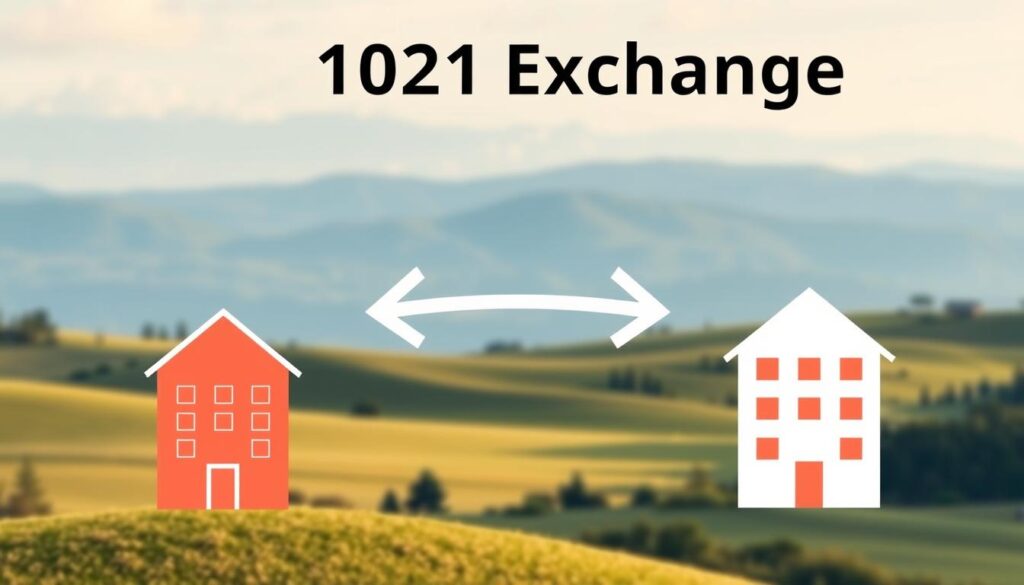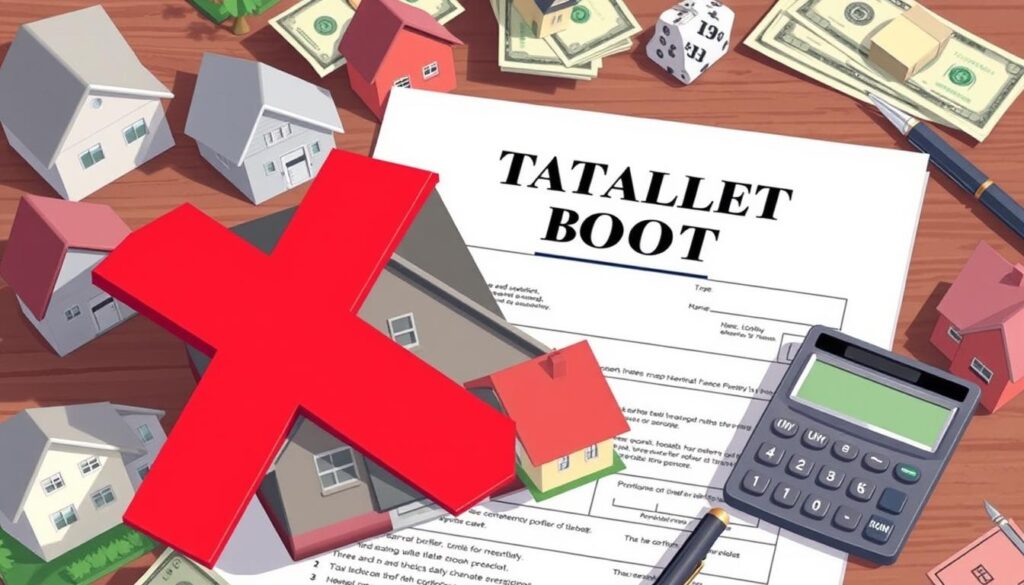A 1031 exchange is a swap of one real estate investment property for another that allows capital gains taxes to be deferred. This process gets its name from Section 1031 of the Internal Revenue Code (IRC), enabling investors to participate in a tax-deferred exchange. By utilizing a 1031 exchange, investors can defer paying capital gains taxes, which typically run between 15% and 30%, by reinvesting sale proceeds into a similar property, known as a like-kind property, used for real estate investing.
Real estate investors can benefit from a 1031 exchange, a tool in real estate investing, by exchanging a property for another of equal or greater value. This guide will walk you through the process of using a 1031 exchange for your real estate investing needs, covering the basics of a tax-deferred exchange and providing valuable insights into leveraging 1031 exchanges for your real estate portfolio growth.
Understanding the intricacies of 1031 exchanges is crucial for real estate investors looking to maximize their investments while deferring capital gains taxes. Whether you’re a seasoned investor or just starting out in real estate investing, this guide will provide you with the necessary information to navigate the 1031 exchange process efficiently and adhere to IRS regulations, ultimately helping you make the most of your tax-deferred exchange.
Table of Contents
Key Takeaways
- A 1031 exchange allows investors to defer capital gains taxes by exchanging one property for another of equal or greater value.
- Properties swapped in a 1031 exchange must be “like-kind,” such as properties used for investment or business purposes, and are a key part of real estate investing.
- Investors have 45 days to identify a replacement property and 180 days to complete the purchase after selling the relinquished property, an essential aspect of a tax-deferred exchange.
- The IRS allows the naming of multiple replacement properties in a 1031 exchange, giving more flexibility in choosing properties to close on within the specified time frame, which is beneficial for real estate investing.
- There is no limit on the number of 1031 exchanges that can be done, making it a valuable tool for real estate investors looking to maximize their investments and utilize a tax-deferred exchange.
- 1031 exchanges do not apply to primary residences, second homes, stocks, bonds, or partnership interests, and are specifically designed for real estate investing and tax-deferred exchange purposes.
Understanding the Basics of 1031 Exchange for Real Estate Investing
A 1031 exchange allows investors to defer capital gains tax on the sale of one investment property by reinvesting the proceeds into another like-kind property. This process enables investors to grow their portfolios while deferring taxes, making it a powerful tool for real estate investing. To learn more about the basics of real estate investing, visit real estate investing made simple.
The concept of a 1031 exchange is based on the idea of tax deferral, where the capital gains tax is deferred until the new property is sold. This can be beneficial for investors who want to reinvest their proceeds into another investment property. Some key terms to understand in the context of 1031 exchanges include like-kind exchange, which refers to the exchange of one investment property for another of similar nature or character.
Here are some key points to consider when it comes to 1031 exchanges:
- Like-kind exchange: The exchange of one investment property for another of similar nature or character.
- Tax deferral: The deferral of capital gains tax until the new property is sold.
- Investment properties: Properties held for investment purposes, such as rental properties or commercial buildings.
By understanding the basics of 1031 exchanges, investors can make informed decisions about their investment properties and potentially save on taxes. It’s essential to consult with a professional to ensure a smooth and successful exchange process.
Benefits of Using 1031 Exchanges in Real Estate
Investors can significantly boost their investment power by utilizing 1031 exchanges, which offer tax deferral benefits that can be reinvested into their investment strategy. This allows them to acquire higher-value properties, accelerating portfolio growth and wealth accumulation. By deferring capital gains tax, investors can retain more of their profits, enabling them to invest in more substantial properties and increase their potential for long-term gains.
A key advantage of 1031 exchanges is the ability to diversify real estate holdings, reducing potential risks and increasing the potential for returns. Investors can use 1031 exchanges to consolidate multiple properties, reducing administrative and maintenance responsibilities, or shift their investment focus to more profitable markets. This flexibility enables investors to adapt to changing market conditions and make informed decisions about their investment strategy.
- Deferral of capital gains tax, allowing for indefinite deferral of tax liability
- Ability to diversify real estate investments across different markets or asset types
- Consolidation of multiple properties, reducing administrative and maintenance responsibilities
- Option to leverage pre-tax dollars, substantially increasing purchasing power and wealth-building potential
By incorporating 1031 exchanges into their investment strategy, investors can create a more efficient and effective approach to real estate investing, maximizing their potential for portfolio growth and long-term success.
| Benefits of 1031 Exchanges | Description |
|---|---|
| Tax Deferral | Deferral of capital gains tax, allowing for indefinite deferral of tax liability |
| Diversification | Ability to diversify real estate investments across different markets or asset types |
| Consolidation | Consolidation of multiple properties, reducing administrative and maintenance responsibilities |
Types of Properties Eligible for 1031 Exchanges
When it comes to 1031 exchanges, the types of properties that are eligible can be quite broad. The like-kind rule is surprisingly liberal, allowing for the exchange of one type of investment property for another. For example, you can exchange raw land for improved real estate, or oil and gas royalties for a ranch. The key is that the properties must be held for investment purposes or for productive use in a trade or business.
Some examples of eligible properties include residential, commercial, industrial, or retail rental properties. These properties can be exchanged for other types of real estate, such as apartments, convenience stores, or office buildings. It’s worth noting that investment real estate can be a great way to diversify your portfolio and potentially increase your returns.
The following table summarizes some of the key points to consider when it comes to eligible properties for 1031 exchanges:
| Property Type | Eligible for 1031 Exchange |
|---|---|
| Residential rental properties | Yes |
| Commercial properties | Yes |
| Industrial properties | Yes |
| Raw land | Yes |
| Primary residences | No |
By understanding the like-kind rule and the types of properties that are eligible for 1031 exchanges, you can make informed decisions about your investment real estate portfolio and potentially save on taxes. Remember to always consult with a qualified tax professional or real estate expert to ensure you are in compliance with all applicable laws and regulations.
Critical Time Constraints in 1031 Exchanges
When it comes to 1031 exchanges, time is of the essence. The IRS imposes strict deadlines to prevent misuse of the tax deferral benefits. Two key timing rules are crucial: the 45-day rule for identifying replacement properties and the 180-day rule for closing on the new property. Understanding these time constraints is vital to ensure a smooth exchange process.
The 45-day identification period begins when the original property is sold, and the investor must identify potential replacement properties in writing within this timeframe. The exchange period, on the other hand, lasts for a maximum of 180 calendar days, during which the investor must acquire the replacement property. Failure to meet these deadlines can result in the exchange being disqualified, and the investor may be required to pay capital gains tax.
To manage these tight deadlines effectively, investors should start the exchange process early and work with a qualified intermediary to ensure compliance with the time constraints. It’s also essential to identify enough potential replacement properties during the identification period to avoid common mistakes. By understanding the 45-day rule and the 180-day rule, investors can navigate the 1031 exchange process with confidence and achieve their investment goals.
- Identify potential replacement properties within the 45-day identification period
- Close on the new property within the 180-day exchange period
- Work with a qualified intermediary to ensure compliance with time constraints
By following these guidelines and understanding the critical time constraints, investors can ensure a successful 1031 exchange and achieve their investment objectives.
| Time Constraint | Description |
|---|---|
| 45-day rule | Identify potential replacement properties in writing within 45 days of selling the original property |
| 180-day rule | Close on the new property within 180 days of selling the original property |
The Role of Qualified Intermediaries
A qualified intermediary, also known as an exchange facilitator, plays a crucial role in ensuring a smooth 1031 exchange process. This third-party intermediary holds the cash after you “sell” your property and uses it to “buy” the replacement property for you, acting as an escrow holder. By doing so, they facilitate the exchange and help you comply with IRS regulations.
When selecting a qualified intermediary, it’s essential to consider their experience, customer service level, insurance coverage, safeguards for funds, and fee structure. A reputable intermediary will guide you through the process, manage paperwork, deadlines, and coordination with other parties involved, ensuring a hassle-free experience for investors.
The use of a qualified intermediary offers a level of protection to investors by keeping funds separate from personal assets, reducing the risk of legal disputes. By hiring a qualified intermediary, investors can focus on identifying replacement properties without handling the administrative tasks of the exchange, allowing them to navigate the strict deadlines and complex rules of 1031 exchanges with ease.
Steps to Initialize Your 1031 Exchange
To start a 1031 exchange, you need to identify the relinquished property you want to sell and the replacement property you want to buy. This process involves choosing a qualified intermediary and notifying the IRS about your transaction. The exchange agreement is a crucial document that outlines the terms of the exchange, including the identification of the relinquished and replacement properties.
The process of initiating a 1031 exchange can be complex, but it can be broken down into several key steps:
- Identify the relinquished property and the replacement property
- Choose a qualified intermediary to facilitate the exchange
- Notify the IRS about the transaction by filing Form 8824
- Complete the exchange within the 180-day time frame
It’s essential to work with a qualified intermediary to ensure that the exchange is done correctly and that all deadlines are met. The intermediary will hold the funds in escrow until the exchange is complete, and they will also provide guidance on the exchange agreement and other documents required for the exchange.
By following these steps and working with a qualified intermediary, you can ensure a smooth and successful 1031 exchange. Remember to always prioritize the exchange agreement and the identification of the relinquished and replacement properties to avoid any potential issues with the IRS.
| Step | Description | Deadline |
|---|---|---|
| Identify relinquished property | Choose the property to sell | Before sale |
| Choose qualified intermediary | Select a qualified intermediary to facilitate the exchange | Before sale |
| Notify IRS | File Form 8824 to report the exchange | Within 45 days of sale |
| Complete exchange | Buy the replacement property | Within 180 days of sale |
Property Identification Rules and Requirements
When it comes to replacement property identification in a 1031 exchange, there are specific rules and requirements that must be followed. The IRS allows taxpayers to designate up to three potential replacement properties, regardless of their value, as long as they eventually close on one of them. This is known as the Three-Property Rule.
For multiple property exchanges, the 200% Rule and the 95% Rule come into play. The 200% Rule permits taxpayers to identify numerous replacement properties as long as the total fair market value does not exceed 200% of the relinquished property’s value. The 95% Rule allows taxpayers to identify more than three properties with a value exceeding 200% of the relinquished property, provided they acquire at least 95% of the identified properties.
The following table summarizes the key rules and requirements for replacement property identification:
| Rule | Description |
|---|---|
| Three-Property Rule | Designate up to three potential replacement properties, regardless of value |
| 200% Rule | Identify numerous replacement properties, total fair market value not exceeding 200% of relinquished property’s value |
| 95% Rule | Identify more than three properties, acquire at least 95% of identified properties |
By understanding these rules and requirements, taxpayers can navigate the replacement property identification process with confidence and ensure a successful 1031 exchange.
Understanding Boot in 1031 Exchanges
In a 1031 exchange, boot refers to non-like-kind property received, such as cash proceeds, installment notes, debt relief, or personal property. The receipt of boot doesn’t disqualify the exchange but introduces taxable gain into the transaction, making it a partially tax-deferred exchange.
To avoid boot, investors should follow three rules: buying replacement property of equal or greater value, reinvesting all exchange funds, and obtaining debt equal to or greater than the relinquished property. Taxable boot can be calculated by dividing the amount of cash boot by the total proceeds from the sale of the relinquished property.
Common examples of boot include cash proceeds received before or after the exchange, non-qualified property like stocks or bonds, and relief from debt relief. Understanding and strategizing to avoid or mitigate boot is crucial for investors aiming to maximize the benefits of a 1031 exchange while reducing tax implications.
By following these guidelines and understanding the concept of boot, investors can navigate the complexities of 1031 exchanges and make informed decisions to achieve their investment goals.
| Boot Type | Description |
|---|---|
| Cash Boot | Cash received in the exchange |
| Mortgage Boot | Difference in mortgage debt between the relinquished and replacement properties |
| Debt Relief Boot | Relief from debt assumptions in the exchange |
Common Mistakes to Avoid During Exchange
When navigating a 1031 exchange, it’s essential to be aware of potential exchange pitfalls that can lead to failed exchanges and jeopardize IRS compliance. One common mistake is failing to consider loans, which can significantly impact the exchange process. For instance, if a taxpayer has a loan on the relinquished property, they must replace it with an equal or greater amount of debt on the replacement property to avoid being taxed on the difference.
To avoid such mistakes, it’s crucial to work with a qualified intermediary who has experience in handling complex transactions. They can help ensure that all requirements are met, including the 45-day identification deadline and the 180-day acquisition deadline. Failure to meet these deadlines can invalidate the 1031 exchange, resulting in significant tax liabilities.
- Ensuring that the replacement property is properly identified within the 45-day timeframe
- Replacing any debt on the relinquished property with an equal or greater amount of debt on the replacement property
- Spending all proceeds from the sale of the relinquished property on the replacement property
By being aware of these potential exchange pitfalls and taking steps to avoid them, taxpayers can ensure a smooth and successful 1031 exchange, maintaining full IRS compliance and avoiding the risks associated with failed exchanges.
Advanced 1031 Exchange Strategies
For experienced investors, advanced 1031 exchange strategies can provide greater flexibility and potential for growth. These strategies include reverse exchanges, where an investor acquires a new property before selling the old one, often with the help of an exchange accommodation titleholder. This can be particularly useful in build-to-suit exchanges, where the replacement property is constructed or improved to meet the investor’s specific needs.
Some key considerations for advanced 1031 exchange strategies include:
- Complex exchanges, which involve multiple properties or parties
- Construction or improvement exchanges, which allow investors to use exchange funds to enhance the replacement property
- Drop and swap arrangements, which enable investors to distribute property under a Tenancy In Common (TIC) arrangement
By understanding and utilizing these advanced strategies, investors can navigate complex exchanges with greater ease and confidence, ultimately achieving their investment goals.
| Strategy | Description |
|---|---|
| Reverse Exchanges | Acquiring a new property before selling the old one |
| Construction Exchanges | Using exchange funds to enhance the replacement property |
| Drop and Swap Arrangements | Distributing property under a Tenancy In Common (TIC) arrangement |
Tax Implications and Considerations
When it comes to 1031 exchanges, understanding the tax implications is crucial. Capital gains deferral is a significant benefit, but it’s essential to remember that it doesn’t eliminate the tax bill entirely. Instead, it postpones it, allowing investors to reinvest their funds into a new property. However, depreciation recapture can still apply, and taxpayers will be taxed at a rate of 25% on all depreciation recapture on the sale of investment property.
A key consideration is the potential for stepped-up basis, which can eliminate deferred taxes for heirs. This strategy can be particularly useful when combined with estate planning. By understanding the tax implications and considerations, investors can make informed decisions about their long-term investment strategy.
Some key points to consider include:
- Capital gains tax rates can range from 0% to 20%, depending on income level and filing status
- Depreciation recapture can apply to investment properties, including real estate
- Stepped-up basis can provide tax benefits for heirs, but it requires careful planning
By navigating the tax implications and considerations of 1031 exchanges, investors can maximize their investment potential and achieve their long-term goals.
| Tax Consideration | Description |
|---|---|
| Capital Gains Tax | Tax on profit from sale of investment property |
| Depreciation Recapture | Tax on depreciation claimed on investment property |
| Stepped-Up Basis | Adjustment to basis of inherited property |
State-Specific Requirements for 1031 Exchanges
When it comes to 1031 exchanges, state taxes can play a significant role in the process. It’s essential to understand the tax jurisdiction of the states involved in the exchange, as some states have their own rules and regulations regarding 1031 exchanges.
In the case of cross-state exchanges, it’s crucial to consider the state taxes and regulations of both the state where the relinquished property is located and the state where the replacement property is located. This can help avoid any potential issues with state-level capital gains taxes.
Some states have specific requirements for 1031 exchanges, such as withholding taxes on the sale of real estate. For example:
- California requires a 3.3% withholding on certain real estate sales
- Georgia mandates a 3% withholding for specific property sales
- Hawaii applies a 5% withholding on real estate transactions subject to state income tax
Understanding these state-specific requirements can help ensure a smooth and successful 1031 exchange. It’s always a good idea to consult with a qualified tax professional or attorney to navigate the complexities of 1031 exchanges and state taxes.
| State | Withholding Requirement |
|---|---|
| California | 3.3% |
| Georgia | 3% |
| Hawaii | 5% |
Due Diligence in Property Selection
When it comes to a 1031 exchange, selecting the right replacement property is crucial for a successful investment. This process involves a thorough market analysis to determine the property valuation and investment potential of the property. Investors should consider factors such as location, market conditions, appreciation potential, and rental income potential.
A key part of this process is conducting thorough due diligence, which includes analyzing the projected cash flow and ROI of the potential replacement property. This can be achieved by reviewing key metrics such as:
- Occupancy and occupancy trends
- Rental trends and rent rolls
- Quality of lease and length of lease term
- NOI – Net Operating Income
By carefully evaluating these factors and considering the property valuation, market analysis, and investment potential, investors can make informed decisions that align with their investment goals and ensure a successful 1031 exchange.
It’s essential to remember that in a 1031 exchange, investors have a limited time frame to identify and close on replacement properties, with a maximum of 45 days to identify properties and 180 days to close. By working with qualified intermediaries and maintaining accurate documentation, investors can navigate this process with confidence and achieve their investment objectives.
| Property Type | Investment Potential | Rental Income Potential |
|---|---|---|
| Industrial Properties | High | Stable |
| Multifamily Properties | Medium | Steady |
| Self-Storage Facilities | Low | Reliable |
Working with Real Estate Professionals
When navigating a 1031 exchange, it’s essential to surround yourself with a team of experienced professionals. This includes real estate agents who specialize in 1031 exchanges, tax advisors who can guide you through the tax implications, and legal counsel to ensure your exchange complies with all regulations.
A successful 1031 exchange requires careful planning and coordination. Real estate agents can help you find suitable replacement properties, while tax advisors can provide valuable insights into the tax implications of your exchange. Legal counsel can review your contracts and ensure that your exchange is structured correctly.
Here are some key roles and responsibilities to consider when building your exchange team:
- Real estate agents: finding suitable replacement properties, negotiating purchase agreements
- Tax advisors: guiding you through tax implications, ensuring compliance with IRS regulations
- Legal counsel: reviewing contracts, structuring the exchange, ensuring compliance with all regulations
By working with a team of experienced professionals, you can ensure a smooth and successful 1031 exchange. Remember to consult with a qualified tax pro and review IRS Publication 544 for more information on the rules and details of a 1031 exchange.
Documentation and Record Keeping Requirements
Proper documentation is crucial for a compliant and successful 1031 exchange. To ensure a smooth process, it’s essential to maintain accurate and detailed records. One of the key documents required is the IRS Form 8824, which provides a detailed description of the properties involved, timelines, and financial transactions.
A clear audit trail is vital throughout the exchange process, including records of all communications, property listings, and financial transactions. This documentation will help in case of an IRS audit and provide a clear history of the exchange for future reference. The exchange documentation should include all relevant information, such as property ownership documents, tax returns, and correspondence with professionals.
- Property ownership documents
- Tax returns
- Property title and deed
- 1031 exchange agreement with a qualified intermediary
- Identification of replacement property form
By maintaining detailed records and following the required documentation guidelines, investors can ensure a compliant and successful 1031 exchange, allowing them to defer capital gains taxes and reinvest their proceeds into another property.
Conclusion: Maximizing Your Real Estate Investment Through 1031 Exchanges
As we conclude our exploration of 1031 exchanges, it’s clear that this powerful investment strategy can be a game-changer for real estate investors looking to build wealth and grow their portfolio. By deferring capital gains taxes through these exchanges, you can reinvest the full proceeds from a property sale, amplifying your investment strategy and accelerating portfolio growth.
Leveraging 1031 exchanges, savvy investors can continually upgrade their properties, diversify their holdings, and engage in effective estate planning, all while minimizing the impact of taxes on their returns. With careful planning, adherence to IRS guidelines, and the guidance of qualified professionals, you can harness the full potential of 1031 exchanges to maximize your real estate investments for years to come.
As the tax landscape evolves, it’s crucial to stay informed and adaptable in your approach. By viewing 1031 exchanges as part of a broader, long-term investment strategy and keeping your financial goals in mind, you can navigate the complexities of these transactions and unlock new opportunities for portfolio growth and wealth building.
FAQ
What is a 1031 Exchange?
A 1031 exchange, also known as a like-kind exchange, is a tax-deferred real estate transaction that allows an investor to sell one investment property and use the proceeds to purchase another property of equal or greater value.
What is the history and purpose of Section 1031?
Section 1031 of the Internal Revenue Code was first introduced in 1921 to provide tax deferral for investors who reinvest their gains from the sale of one investment property into another property. The purpose is to encourage investment in real estate and promote the efficient allocation of capital.
What are the key terms I need to know for 1031 exchanges?
Some of the key terms include relinquished property, replacement property, Qualified Intermediary, like-kind property, boot, and the 45-day identification period and 180-day exchange period.
What are the benefits of using 1031 exchanges in real estate investing?
The primary benefits of 1031 exchanges include tax deferral, which can significantly boost your investment power, as well as the ability to diversify your portfolio, consolidate properties, or shift investment focus to more profitable markets.
What types of properties are eligible for 1031 exchanges?
Investment properties and certain types of business-use real estate are eligible for 1031 exchanges, as long as they meet the “like-kind” requirement. Primary residences generally do not qualify.
What are the critical time constraints in a 1031 exchange?
Investors must identify potential replacement properties within 45 days of selling the relinquished property and complete the exchange within 180 days. Adhering to these deadlines is crucial for maintaining the tax-deferred status of the exchange.
Why do I need a Qualified Intermediary for a 1031 exchange?
A Qualified Intermediary is a neutral third party that facilitates the exchange and ensures compliance with IRS regulations. They hold the proceeds from the sale of the relinquished property and use those funds to purchase the replacement property on the investor’s behalf.
What are the property identification rules for 1031 exchanges?
The Three-Property Rule, 200% Rule, and 95% Rule provide flexibility in identifying potential replacement properties, allowing investors to consider multiple options while still meeting IRS requirements.
What is “boot” in a 1031 exchange, and how does it affect the transaction?
Boot refers to any cash or non-like-kind property received by the investor in addition to the replacement property. Boot is generally taxable, so investors must understand how to minimize or avoid it to maximize the tax-deferral benefits of the exchange.
What are some common mistakes to avoid when executing a 1031 exchange?
Common pitfalls include improper property identification, missing deadlines, inadvertently taking control of exchange funds, and failing to consider debt implications. Careful planning and working with experienced professionals can help investors steer clear of these issues.
What are some advanced 1031 exchange strategies?
More complex strategies include reverse exchanges, construction or improvement exchanges, and “drop and swap” arrangements. These advanced techniques offer additional flexibility but also come with increased complexity and risk.
How do 1031 exchanges affect my long-term tax situation?
1031 exchanges can provide indefinite tax deferral through successive exchanges, but investors must also consider factors like depreciation recapture and stepped-up basis for their heirs. Understanding the long-term tax implications is crucial for informed investment decisions.
What state-specific considerations do I need to be aware of for 1031 exchanges?
State-level capital gains taxes, geographic restrictions, and unique state-level exchange rules can all have a significant impact on your 1031 exchange. Investors must carefully research the requirements in the states involved in their transaction.
What should I consider when selecting a replacement property?
Thorough due diligence is essential, including analyzing the location, property condition, and long-term investment potential. Professional inspections and market research can help investors make informed decisions that align with their overall investment strategy.
What kind of professionals do I need on my 1031 exchange team?
A successful 1031 exchange often requires a team of experts, including a real estate agent experienced in exchanges, a tax advisor, and legal counsel. Selecting the right professionals and ensuring they work together effectively is crucial for the exchange’s success.
What documentation and record-keeping requirements are involved in a 1031 exchange?
Proper documentation is essential, including IRS Form 8824, property listings, financial records, and communication logs. Maintaining a clear audit trail and adhering to document retention guidelines can help investors prepare for potential IRS scrutiny.









